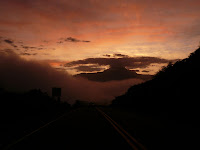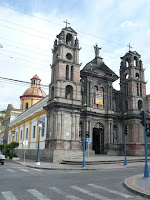
We've been on a handful of weekend "adventure" trips not too far from my current home-base in Arequipa. This post covers everything prior to the May 7 - 15 adventure week coming up at the end of my GVI journey.
Mountain biking down Chachani. On our first Saturday in Peru, I went with Aaron, Maya and Aviv to a nearby mountain called Chachani and rode bicycles down mostly dirt tracks from 4875 M to the city at 2600 M; over 50 KM. The scenery was spectacular. I had a fantastic time riding VERY fast downhill. I picked up a few bumps and bruises along the way, but that's to be expected. Maya and Aviv gave up the struggle early on, put their bikes back on the van and rode the rest of the way down with the bikes on top of the van. Crazy chicas :) Once we got back onto pavement, I rode in front of Aaron and the guide. The road was twisty and smooth and made me wish I had my motorcycle. The guide said we were traveling at 50 KPH most of the way. It was GREAT!
(Link to pics from the Chachani bike trip)
Trekking in Colca Canyon. This 3-day trip took me and 16 other "voluntourists" and our 2 guides all the way down into the largest canyon in the world, then back up again. Our giant group walked most of the way down the first day and slept at a little rustic hostel. In the morning we trekked all the way down for lunch at a little oasis near the river, then the group hiked the way back up 1000 M for a night in Cabanaconde. I hired a mule for the ride back up to the top (well, why not..?) while the others slogged up in the rain. On the third day we goofed around Cabanaconde for a bit before heading to Chivay for a huge buffet lunch, then took the bus back to Arequipa. One highlight from the trip was a peek at some wild condors circling in the valley. (I saw a few up close at the Condor Park in Otavalo.)
This was the most "guided tour"-feeling weekend in all my time with GVI. Because the group was so huge, it was a little hard for me to enjoy the trip (aside from all the rain, I suppose.) Yes, the canyon was gorgeous. The trek wasn't really difficult. The hostels were comfortable. Nonetheless the trip was primarily centered on waiting for others or catching up with others, and it was tough to "be in the moment." Some of the pictures turned out nice, though...
(Link to pics from Colca Canyon trip)
Scenic drive to Salinas Lagoon. Last weekend we took a day-trip to Salinas Lagoon, a salt/borax lake at 4000 M and home to flamingos and other wildlife. The weather was perfect and the views along the very bumpy off-road drive were spectacular. We visited a handful of quaint little pueblos along the way and stopped several times for photos. My highlight for this trip was a visit to a llama farm, where we were followed around by some very tame young llamas out in their pasture.
(Link to pics from Salinas Lagoon trip)
NEXT: More about the GVI school at Sachaca.
Mountain biking down Chachani. On our first Saturday in Peru, I went with Aaron, Maya and Aviv to a nearby mountain called Chachani and rode bicycles down mostly dirt tracks from 4875 M to the city at 2600 M; over 50 KM. The scenery was spectacular. I had a fantastic time riding VERY fast downhill. I picked up a few bumps and bruises along the way, but that's to be expected. Maya and Aviv gave up the struggle early on, put their bikes back on the van and rode the rest of the way down with the bikes on top of the van. Crazy chicas :) Once we got back onto pavement, I rode in front of Aaron and the guide. The road was twisty and smooth and made me wish I had my motorcycle. The guide said we were traveling at 50 KPH most of the way. It was GREAT!
(Link to pics from the Chachani bike trip)
Trekking in Colca Canyon. This 3-day trip took me and 16 other "voluntourists" and our 2 guides all the way down into the largest canyon in the world, then back up again. Our giant group walked most of the way down the first day and slept at a little rustic hostel. In the morning we trekked all the way down for lunch at a little oasis near the river, then the group hiked the way back up 1000 M for a night in Cabanaconde. I hired a mule for the ride back up to the top (well, why not..?) while the others slogged up in the rain. On the third day we goofed around Cabanaconde for a bit before heading to Chivay for a huge buffet lunch, then took the bus back to Arequipa. One highlight from the trip was a peek at some wild condors circling in the valley. (I saw a few up close at the Condor Park in Otavalo.)
This was the most "guided tour"-feeling weekend in all my time with GVI. Because the group was so huge, it was a little hard for me to enjoy the trip (aside from all the rain, I suppose.) Yes, the canyon was gorgeous. The trek wasn't really difficult. The hostels were comfortable. Nonetheless the trip was primarily centered on waiting for others or catching up with others, and it was tough to "be in the moment." Some of the pictures turned out nice, though...
(Link to pics from Colca Canyon trip)
Scenic drive to Salinas Lagoon. Last weekend we took a day-trip to Salinas Lagoon, a salt/borax lake at 4000 M and home to flamingos and other wildlife. The weather was perfect and the views along the very bumpy off-road drive were spectacular. We visited a handful of quaint little pueblos along the way and stopped several times for photos. My highlight for this trip was a visit to a llama farm, where we were followed around by some very tame young llamas out in their pasture.
(Link to pics from Salinas Lagoon trip)
NEXT: More about the GVI school at Sachaca.













